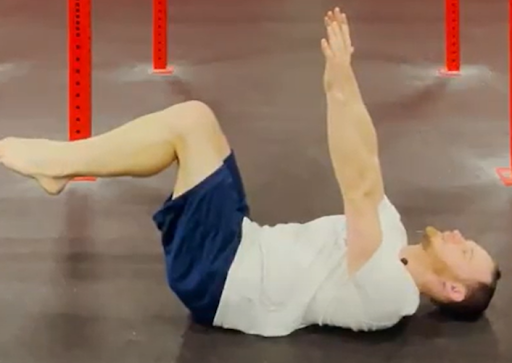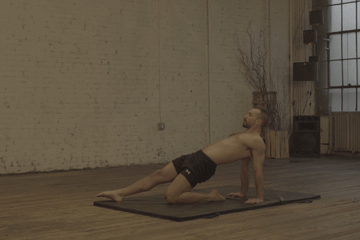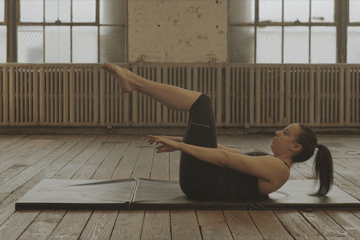Are you having trouble keeping your lower back on the floor during hollow holds? This is a common problem encountered by many strength and fitness enthusiasts.
Hollow hold requires an extreme level of 📍core strength and stability that some people simply don’t have.
How to keep the lower back on the floor during hollow hold?
So, how to keep the lower back on the floor during hollow hold?
The solution is to regress the hollow hold or essentially make it easier. This can be done by reducing the range of motion, changing the angle of your body, and modifying the position of your arms and legs. The dead bug is one of the best regression exercises for hollow holds. You can also try the knee tuck hold, the supine hollow hold, the straddle hollow hold, and many more.
Don’t force yourself to carry on with a hollow body hold that doesn’t correspond to your objectives or current skills – instead, try some regressions that can help you build the strength and stability needed for the classic version.
In this article, we will discuss the basics of hollow hold and the regressions you can do that can help you build a strong and stable lower back to be able to progress to the more challenging level of the exercise.
Related article: 📍Strengthen The Muscles of The Lower Back & Relief Pain
🧐Overview of Hollow Hold
So before we proceed to the regressed versions, let’s quickly review what hollow holds are and how it works.
The hollow hold is an isometric exercise that challenges your core muscles to keep you in a stable position while maintaining good posture.
Hollow hold allows you to work your deep abdominal muscles and improve your lower back strength. In addition, it’s a great way to build stability in your core and overall body control.
There are several versions of the hollow hold, and these can be regressed or progressed depending on your current level and goals.
When you are experiencing lower back pain or shoulder pain, working on the hollow hold can help you to strengthen your core, improve your posture and reduce pain.
How to do hollow hold?👇
To perform the hollow hold, you must lie down on your back and extend your arms overhead. Then, strengthen your legs with feet together and toes pointed.
Next, tighten your core and press your lower back into the ground, so it stays in contact with the floor throughout the entire movement.
Next, lift your arms, feet, and legs off the ground, keeping your neck and shoulders relaxed.
Breathe deeply as you hold this position for 30-60 seconds. Release when done, and repeat up to three times, depending on your fitness level.
You must keep your core engaged throughout the entire movement, which helps create tension and stability in your body.
This exercise works several muscle groups, including the rectus abdominis, transverse abdominis, obliques, glutes, hip abductors, and adductors. It also improves stability throughout the body and can help build a strong core.
🏆Benefits of the Hollow Hold
The hollow holds offer several benefits for both experienced and novice users.
✔️Strengthens the core muscles and improves spinal stability
Doing hollow holds can help strengthen your core muscles and spinal stability in the body by forcing your abdominal muscles to work together.
✔️Improves posture
Hollow holds can help improve your posture by strengthening the muscles in your back and helping them become more resilient.
✔️Reduces stress
The hollow hold is a great way to relax and reduce stress levels, as it encourages mindful breathing and slow controlled movements.
It can also help ease tension in your neck and shoulders, which can often be caused by stress.
✔️Builds flexibility
Hollow holds also stretch and lengthen the muscles in your abdomen and lower back, allowing them to become flexible and less prone to injury.
✔️Builds a stronger lower back
When it comes to building strength in your lower back, the hollow hold is an excellent exercise. It works your deep abdominal muscles and strengthens the muscles in your lower back and hips, allowing you to increase stability and prevent injury.
✔️Reduces lower back pain
If you have lower back pain, the hollow hold can help reduce it. The exercise increases core strength and stability, which helps to reduce back pain in your lower back.
✔️Address shoulder pain
Hollow holds target the muscles in your shoulders and upper back, helping them become stronger and more resilient.
💯Top 4 Regressed Versions to Try
Now that you know the benefits of doing hollow holds, let’s take a look at four regressed versions you can try if you’re starting or need an easier version.
✊The Dead bug
The dead bug is by far the best exercise for hollow hold regression. This exercise will help you learn the correct breathing pattern and teach your muscles how to create tension in the core without compromising posture or alignment.
To perform this exercise, lie flat on your back, keeping your lower back on the ground, and your arms are just vertical. Your knees are on top of your hips, and your back is flat on the floor.
After this, you can extend one or both of your arms. This makes the body a bit longer, and you can do the same with your legs. You can do foot taps.
Again, those are some modifications to scale it back to a smaller position, which was the dead bug, and just gradually making the body longer but emphasizing the lower back being flat.
You may find the following articles helpful if you want to know more about correct breathing techniques during exercise:
- 📍The Proper Way to Breath during Exercise to Maximize Performance
- 📍Proper way of breathing while doing Ab exercises
✊The Knee tuck
The knee tuck is another excellent exercise to learn the hollow hold. It is great for those who can’t hold the traditional hollow hold for an extended period. To perform this exercise, start by lying flat on your back with your arms and legs extended. Next, with your core engaged, bend one knee towards your chest while keeping the other leg straight and off the ground. Then lower your bent leg back to starting position and repeat with the opposite side. Again, remember to keep your core engaged and your hips still throughout the movement.
✊Partial range of motion hollow hold
This variation is a great way to get used to the feeling of the hollow hold without having to hold the full range of motion.
To do this, start in a half-hollow position where your knees are bent, and feet are off the ground. Ensure your back is flat against the floor and your core is engaged. Hold this position for 10-15 seconds before releasing the tension and returning to starting position.
✊Straddle hollow hold
Another regression of the hollow hold is called the straddle hollow hold. This exercise helps to increase the stability of your core muscles while lying on the ground.
To do this, start by sitting straight with your legs in a wide straddle position and both arms extended out in front of you. Then, slowly lower your upper body with your core engaged, aiming for a V-shape with your arms and legs. Keep your back and spine flat against the floor as you hold this position for at least 10-15 seconds. You can make this exercise more challenging by raising your arms above your head or extending one leg straight, but remember to maintain proper form throughout the movement.
🎯Hollow Hold Progressions to Try
After being comfortable with the regressed versions of the hollow hold, you can progress to more challenging variations. Here are four variations you can try when you’re ready for a challenge:
👊The Full Hollow Hold
This classic version of the hollow hold will work your core muscles to their fullest potential.
To do this, start by lying flat on your back with your arms and legs extended. Then, with your core engaged, scoop your belly button towards the floor while pressing your lower back into it. Next, lift both legs off the ground, then lift both arms to reach the ceiling. Hold this position for 10-15 seconds before releasing the tension and returning to starting position.
👊The Superman Hollow Hold
This variation of the hollow hold is excellent for targeting your lower back muscles. Start by lying flat on your stomach with your arms extended straight out in front of you. With your core engaged, lift both legs and arms off the ground, creating a Superman-like pose. Hold this position for 10-15 seconds before releasing the tension and returning to starting position.
👊The Plank Hollow Hold
This variation of the hollow hold is excellent for mastering proper plank form while strengthening your core muscles at the same time. Start by getting into a high plank position with your arms extended and your feet hip-width apart. Then, with your core engaged, draw your belly button towards the floor and press your lower back into it. Hold this position for 10-15 seconds before releasing the tension and returning to starting position.
Related article: 📍Advanced Plank Exercises for Insane Core Strength
👊The Balance Hollow Hold
This variation of the hollow hold focuses on balance and core strength.
To do this, start by standing on one foot while the other is lifted off the ground. Then, with your core engaged and your belly button is drawn towards your spine, slowly lower your upper body until it creates a 45-degree angle with the floor. Hold this position for 10-15 seconds before releasing the tension and returning to starting position. Repeat on the other side.
These four variations of the hollow hold will surely challenge your core muscles, regardless of your level. Always practice proper form throughout each exercise, and listen to your body if it’s telling you something is too difficult or hurts. Have fun with these exercises, and enjoy the results!
🥺Common Error When Performing Hollow Hold
While hollow hold can be beneficial when done correctly, it’s important to be aware of some common mistakes people make while performing the hollow hold. Here are some common errors to avoid when doing the hollow hold:
❌Arched low back
One common error when doing the hollow hold is an arched low back. This occurs when the lower back loses its natural curve and creates a concave shape in the lumbar spine instead. This can happen due to weak core muscles, improper form, or lack of proper technique during the exercise. To correct this, focus on engaging your core muscles and pressing your lower back into the floor.
❌Shrugging shoulders
Another common error when doing the hollow hold is shrugging off the shoulders. This occurs when people overcompensate using their shoulder muscles instead of core muscles to keep themselves up in the hollow hold position. To correct this, focus on engaging your core muscles and creating a solid foundation before lifting the arms.
❌Loosening of form
A third common error when doing the hollow hold is the loosening of form. This occurs when people lose their form or start to slouch while in the hollow hold position. To correct this, focus on maintaining proper form throughout the entire exercise and ensure that your core is engaged.
❌Shallow breathing
When doing the hollow hold, it is important to avoid shallow breathing. Shallow breathing happens when you take short and shallow breaths instead of deep and full breaths. Shallow breathing can lead to dizziness and fatigue, so focusing on taking deep breaths throughout the exercise is essential. This can make the exercise more complex, so make sure to take deep breaths while doing the hollow hold!
❌Neglecting lower body tension
Another common error is having flappy legs or ‘dead weight‘ during the hollow hold. This can happen if you forget to engage your lower body and neglect the tension in your legs and feet. To correct this, focus on squeezing your legs together forcefully, making it more challenging for your core muscles to support the weight of your body.
By being aware of these common errors and focusing on proper form during the hollow hold, you can maximize the benefits of this exercise and ensure that you are getting the most out of it!
🧐Frequently Asked Questions
🔎What is four common variations of the hollow hold?
A: Common variations of the hollow hold include full hollow holds, Superman Hollow Holds, Plank Hollow Holds, and Balance Hollow Holds. All exercises should be performed using proper form to ensure safe execution.
🔎How do I properly engage my core muscles during a hollow hold?
A: To ensure that you are engaging your core muscles during a hollow hold, draw your belly button towards the floor while pressing your lower back into it. This will help keep your body steady and stable throughout the exercise.
Also, focus on proper breathing techniques to help you maintain the correct form.
🔎How often should I do hollow holds?
A: You should aim for two or three sessions per week of hollow holds, with each session lasting approximately 10-15 minutes. As your body becomes stronger and more accustomed to the exercise, you can increase the duration and frequency of your sessions. Be sure to listen to your body; if you’re tired or sore, taking a break from hollow holds is okay for a few days.
🔎What muscles do hollow holds target?
A: Hollow holds are great for targeting and strengthening your core, glutes, and lower back muscles. The exercise can also help improve your balance and stability.
🔎What is the best way to progress with hollow holds?
A: As your body becomes stronger, you can try increasing the duration of each hold or adding in more difficult variations of the exercise, such as balance hollow holds or Superman hollow holds. Additionally, you can also increase the difficulty of the exercise by using weights or resistance bands to add extra resistance.
It’s important to ensure that you’re always practicing proper form throughout each exercise and listening to your body if it’s telling you something is too difficult or hurts. Taking breaks in between sets or exercises will help ensure that your muscles are properly rested and ready to take on the next challenge.
Happy hollow holding!
🔎What other exercises can I do to strengthen my core?
A: Along with hollow holds, you can do many other great exercises to strengthen your core. These include planks, mountain climbers, Russian twists, flutter kicks, and 📍leg lifts. Incorporating various exercises into your routine can help keep your workouts fresh and challenging.
🔎Are there any other benefits associated with doing hollow holds?
A: Besides strengthening your core, hollow holds can help improve balance, stability, posture, and mobility. The exercise can also help with mental clarity and focus, which is especially beneficial when doing other physical activities.
Always practice proper form throughout each exercise to ensure safe execution, and have fun while you’re at it! Enjoy the results of these exercises. Happy hollow holding!
🔎What are the best tips for starting a hollow hold routine?
A: To get the most out of your hollow hold routine, here are some helpful tips to keep in mind:
- Start with shorter holds and build up to longer ones.
- Make sure you’re engaging your core muscles properly.
- Focus on proper breathing throughout each exercise.
- Keep your movements slow and controlled for maximum effectiveness.
- Take breaks in between sets to help ensure your muscles are properly rested and ready to take on the next challenge.
- Listen to your body; if something feels too difficult or uncomfortable, take a break and try again later.
🔎How often should I do hollow holds?
A: It is recommended to do hollow holds two to three times a week to allow your body enough time to rest and recover between workouts. However, it is important to listen to your body and ensure you are not overworking yourself. If something feels too difficult or uncomfortable, take a break and try again later.
🔎What muscles do hollow holds target?
A: Hollow holds primarily target your core muscles, including the transverse abdominis, rectus abdominis, obliques, and lower back. Additionally, they also help improve balance and stability.
🔎How long should I hold each hollow?
A: The length of your holds will depend on your current fitness level and goals. If you’re just starting out, it is best to start with shorter holds and gradually build up over time. Listen to your body – if something feels too difficult or uncomfortable, take a break and try again later.
🔎How effective are hollow holds?
A: Hollow holds are an incredibly effective and efficient exercise for strengthening your core muscles. The exercise can help improve balance and stability, as well as improve posture and mobility. The exercise can also help with mental clarity and focus, which is especially beneficial when doing other physical activities.
🔎I have back pain, can I still do hollow holds?
A: If you have back pain, it is best to consult your healthcare provider before trying hollow holds. If you are cleared for the exercise, start off cautiously and ensure that you are performing the exercise with proper form. Also, listen to your body; if something feels too difficult or uncomfortable, take a break and try again later.
📌Conclusion
The hollow hold is a great exercise for developing core strength and stability,🤛 which is often overlooked.
It can help improve posture, mobility, and mental clarity and strengthen your core muscles.
But most people are having trouble keeping their lower back during hollow holds.
Hollow hold can be difficult if you don’t develop the necessary muscles. If you’re having trouble with the regular version of the exercise, try regressions that can help build up your strength until you can do the full movement.
👉The dead bug is a great regression exercise, as it helps you get used to having a hollowed-out spine while engaging your core muscles.
Remember to focus on bracing your core throughout the entire exercise, no matter what variation you’re doing.
Take the time to practice proper form and listen to your body; if something feels too difficult or uncomfortable, take a break and try again later.
💪For a more tailored approach to calisthenics training, check out The Movement Athlete.
🌟Get a free assessment to understand your needs and create a tailored plan just for you. SIGN UP now.





